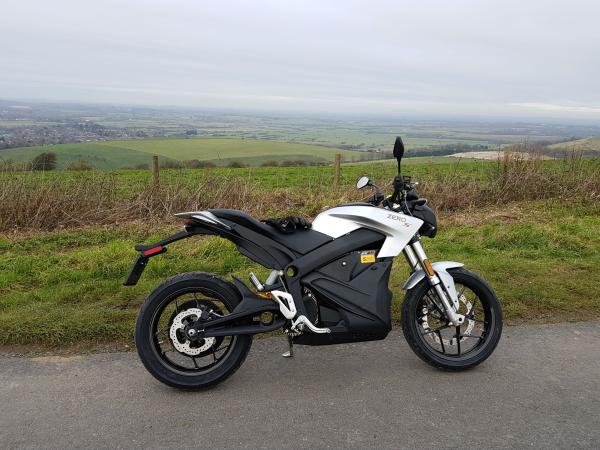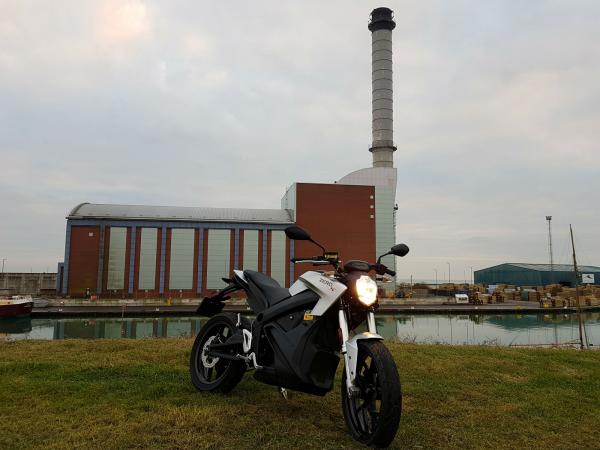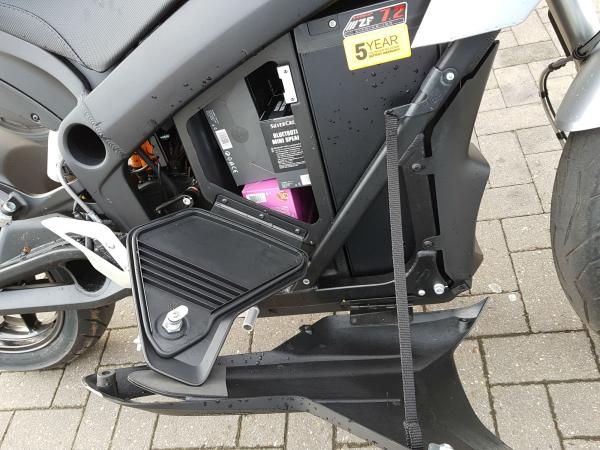First ride: Zero S review
We ride the 2018 Zero S ZF7.2 11KW

Member for
54 years 8 monthsTHIS year we learned that the Government wants to ban new fossil-fuel-powered vehicles from 2040. While there was no specific mention of motorcycles, there seems no reason currently to be confident they will be excluded.
Of course, it doesn’t mean petrol-powered motorcycles will disappear from the roads overnight. They could remain a common sight for decades, just as we still see the odd two-strokes, spewing out their unburned fuel in a cloud of stinky blue smoke. They could be given longer than cars to meet the requirement, as is the habit currently with progressive new emission limits.
But, it presents the possibility that by 2039, all the new bikes revealed at the autumn shows will be electric. No V-fours, parallel-twins or V-twins. Only motors and batteries. Super-charging? A death-throw of the internal combustion engine, eking it out for a few more years by squeezing more power from less fuel.
And manufacturers are hardly likely to wait until the last minute to adapt their ranges. So, even though the scenario described is at present only a possibility, we’re likely to see more and more electric production motorcycles from here on in.
Like this one. It’s the 2018 Zero S ZF7.2 11KW. I’ve been dipping a toe into the future by riding it for a few days. This is my report.
Engine
You see? Such is the momentousness of the change that even the standardised sections of Visordown’s motorcycle reviews will have to be torn up and re-written. There is no engine.
But I’ll press on.
The motor makes a claimed 31hp and 79lbft, pushing the bike to an (also claimed) top speed of 80mph, where it seems to arrive at a limiter. So that’s roughly the torque of a 959 Panigale, power of a CBR300R and top speed of an R125.
It’s the peak torque that you’ll notice as you ride it. As an electric bike, it makes it available not at a specific engine speed but in proportion to how much you open the throttle. So it’s not really ‘peak’ torque at all, since there’s no power curve. More just a maximum or ‘net torque’, which is how it’s expressed on the specs sheet.
Everything is different.
There’s no clutch – this is a twist-and-go – and the throttle response is a little indirect. As on a twist-and-go scooter, open it fully from a standstill and it will get you rolling before giving you everything you’ve asked for. No doubt for the best.
There’s no traction control. These days it’s found on machines that barely seem to justify it, like Vespa’s GTS 125, but the Zero S is one motorcycle for which it would do no harm.
I got it wrong once, making the rear step out quite a lot as I pulled out of a turn onto a damp road. The Pirelli Diablo Rosso II tyre just completely span-up. And while I’m not new to bikes, some riders of the Zero S may be, because it’s learner legal. Although its ‘net power’ figure is more than double that usually allowed, it has a separate ‘continuous power’ rating, referring to the horses it can deliver over a specified range, and that’s bang on the learner money, at 15hp, or 11kW.
There’s the option of a bigger battery (14.4kWh instead of 7.2kWh), pushing net power to 59hp and net torque to 80lbft – but ‘continuous power’ is still rated at 15hp, so it remains learner legal.
It’s an unfathomable anomaly in the rules which I doubt the rule-makers fully understand. So let’s keep quiet about it.
Like the Zero S. With the ignition key turned to ‘on’, it’s ready to go as soon as you touch that throttle – in complete silence.
That could catch you out, if you forget you’ve turned it on and twist the throttle playfully, as we sometimes do, expecting nothing to happen.
But slightly more unnerving is its tendency to take a moment to come to life after you turn the ignition key. At first it’s unresponsive. You twist the throttle and nothing happens. And suddenly it wakes up just as you investigatively twist again, wondering what's going on, and the torque response feels like being shunted by a bus because you’re not quite expecting it. Zero points out there’s a little green half-circle light on the dash which flashes at first and stays on constantly when it’s ready to go. I say people could still get taken by surprise.
Once it's moving, and your mind and wrist has had a chance to calibrate to the throttle response, it's smooth when handled delicately.
It’s silent initially as you move off, too, but as it gathers speed, and you open the throttle further, it makes whirring noise, like a milk float.
It’s a bit faster than a milk float, though. You’ll probably find yourself playing with that torque, opening the throttle whenever conditions permit, just because it’s fun.
You may also enjoy the stares from other road users, wondering if they’ve gone deaf, especially when you pull up at traffic lights.
There are two riding modes to choose from, Sport and Eco, depending on whether you want to go fastest or farthest. Close the throttle and you’ll find there’s a degree of artificial engine braking, which is the Zero S using your momentum regeneratively to recharge the battery a bit. It’s not like real engine braking, just a little resistence.
Its claimed range is 88 miles in the city; 44 miles at 70mph; or 60 miles on a combination of roads So it’s not quite ready yet for the Route 66 tour. Plug it in to a domestic socket with a kettle lead (yes) and it recharges fully in a five hours and 12 minutes, at a claimed typical cost of £1.30. A 95% charge is reached in four hours and 42 minutes.
Those times can be reduced to one hour and 36 minutes for a full charge and an hour and six minutes for 95%, with accessory chargers. From 2018, a 6kW ‘charge tank’ reduces them further, to one-and-a-half hours for a full charge and an hour exactly for 95%. The charge tank is a factory-fitted option costing £2,300. All 2018 models can still be plugged in at a domestic socket but a public charging point must be used to take advantage of the faster times offered by the charging tank.
The model I tested basically seems to be the city bike amongst Zeros line-up, with others achieving much longer ranges.
There are advantages to having a shorter range and smaller battery, which are the reason for the model’s existence. One is price. It costs £10,690, while some longer-range models are several thousand pounds more expensive. A £1,500 government grant brings the price down to £9,190.
Handling
The other advantage is weight. The model I tested weighs a claimed 142kg while others in the range are up to 63kg heavier.
And that’s kerb weight. Can you think of the last time you rode a motorcycle as light as that? KTM’s 125 Duke weighs a claimed 137kg – dry.
The bars are high, the riding position upright and the seat a little hard (not that it matters with the Zero S’ range), while that low weight ensures easy, precise, toy-like handling. Helped by the…
Suspension
Which is pretty good. It’s from Showa and adjustable for preload, compression and rebound damping at both ends.
At the front is a 41mm upside-down fork and at the rear a piggy-back reservoir shock. It’s firm, sporty, competent. Not made for all-day comfort but, again, neither is the range.
Brakes
At the front is a 320mm disc, mounted to the middle of the cast aluminium wheel spokes, with a two-piston sliding caliper. It doesn't feel quite as powerful as that disc size might suggest but stops you quickly given a sufficient squeeze on the lever. The bike I tested developed a front brake squeak.
Meanwhile the rear feels a bit dead. It’s a single-piston sliding caliper on a 240mm disc. Pushing down a bit on the pedal, I could still roll the bike backwards on a hill at traffic lights. In motion, it takes a firm press.
Equipment
Along with those riding modes I mentioned earlier, Bosch ABS is standard.
The digital dash tells you what percentage charge is remaining and your range to flat.
You get a lockable luggage compartment where the petrol tank would normally be. The test bike was delivered with the kettle lead in there. Coincidentally, the compartment looks to be about the right size for a kettle.
There are two little wire cables which can be used as separate low-security helmets locks by hooking the ends on little knobs under the storage compartment door before shutting it.
On this shorter-range model, the smaller battery allows space for an additional lockable luggage compartment behind it, shown below filled with Christmas shopping.
We like
The ease with which it is recharged. Just plug it in at home, or at a public charging point if you’ve got the charge tank. Options like these make the electric motorcycle begin to seem viable as a replacement for petrol ones.
Also, the low maintenance belt final drive. More motorcycles should have these.
We don’t like
The sheer weight of choices and technical information could be overwhelming for consumers. The model I tested is called the ‘Zero S ZF7.2 11KW’ because it’s a Zero S making 11KW from a 7.2kWh battery. Do we need the specs in the bike name?
You’re given the range for the city, motorway and combined; and the charge time for 100% and 95%. Those times differ based on having accessory chargers of the charge tank. Bigger-batteried models also have an optional ‘power tank’ increasing range and meaning different specs again. And the power tank and charge tank specs are mutually exclusive. You can’t have both together because they occupy the same space on the motorcycle. It’s got to be either/or.
The options and specifications of petrol motorcycles may appear complicated to the uninitiated too, but that’s the challenge facing electric bike makers. Most motorcyclists are uninitiated to electric bikes.
New technology is embraced when it’s simplified. How many iPhone users know the speed of the device’s processor? Not as many as don’t. People buy them knowing broadly what they’re capable of. ‘Zero S ZF7.2 11KW’ means nothing to someone who hasn’t studied electric bikes and the Zero the range. How about calling it the ‘Zero S City’?
Also, the photo below shows a crack in a side panel which appears to have been caused by the pressure of the fastener that secures it in place.
Verdict
I did a Facebook Live video while I tested the Zero S in which I suggested that, like it or not, the petrol engine’s days were numbered and this was the future. The post got lots of shares and likes but also some of those little Facebook crying faces.
I think anyone dismayed by a future of electric motorcycles would comforted by trying one. By realising that they are different, yes, but still motorcycles.
Some of the riding characteristics are new but the throttle is still addictive. This much torque immediately available will never be boring.
While the model I tested had a modest range, electric bikes are advancing that respect. Zero’s given all its models 10% more range for 2018. One, with the power tank, will do 111 miles at 70mph and recharge to 95% in two hours and 48 minutes. With the charge tank instead of the power tank, it will recharge to 95% in two hours exactly, and still manage 90 miles at 70mph. That’s while making 69hp and 107lbft, and with claimed top speed of 101mph.
And we’re still only at the start. When the news emerged in July that new vehicles were to be electric from 2014, Steve Kenward, CEO of the Motorcycle Industry Association, welcomed it as a “tremendous commercial trigger to push on with electric motorcycles”.
So imagine what electric bikes of a few years’ time will be like. I’m looking forward to finding out.
Specs
Model tested: Zero S ZF7.2 11KW
Price: £10,690 (£9,190 with £1,500 government grant)
Motor: 11kW electric
Power: 31hp (continuous power 15hp)
Torque: 79lbft
Kerb weight: 142kg
Range: 44 miles at 70 miles, 88 in the city or 60 miles on a combination of roads
Charge time: At a domestic socket, 100% in five hours and 12 minutes or 95% in four hours and 42 minutes. With option £2,300 charge tank and public charging point, 100% in one-and-a-half hours and 95% in one hour.
Typical household cost of a charge: £1.30



















